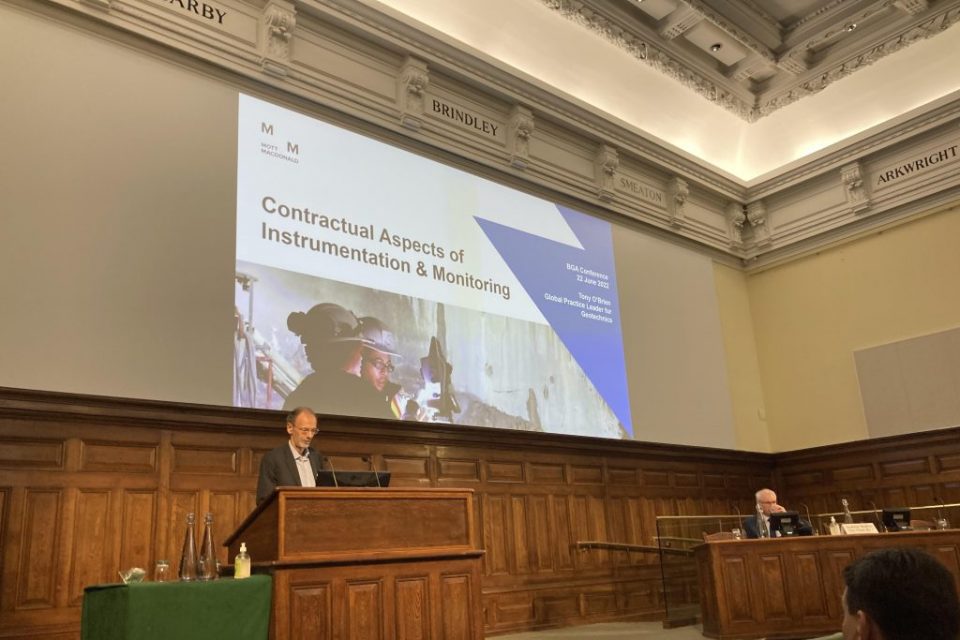There is a need for more comprehensive commercial guidance for procurement and contract clauses for the use of instrumentation and monitoring, according to Mott MacDonald’s Tony O’Brien.
At last week’s British Geotechnical Association annual conference, Mott MacDonald global practice leader for geotechnics and Fellow of the Royal Academy of Engineering Tony O’Brien discussed contractual issues related to instrumentation and monitoring (I&M).
In his view high quality I&M has already stimulated step change improvements in the understanding of geotechnics in terms of ground movement behaviours.
More recently, there have also been some significant improvements in I&M technology, including interferometric synthetic aperture radar (InSAR) and fibre optic measurement systems.
“There have also been improvements in technology in terms of how we can back analyse the data. We’re currently working with SAALG and its Daarwin software, which is using machine learning technology. And we’re currently undertaking a trial with HS2 which has been very positive,” O’Brien said.
“I think we’re on the cusp of another significant step change in geotechnics, but we need to organise ourselves better.”
So, while there is good technology available, O’Brien stressed that the industry is not making the best use of it – and that procurement practices are holding the industry back.
“A major barrier is really around the way conventional contracts are set up,” he told the audience. “I think we need to adapt contract conditions to give ourselves more opportunities in the future.”
O’Brien is the co-author of a book on The Observational Method in Civil Engineering and also involved with an international committee (ISSMGE’s TC206) looking to advise on how contracts can be adapted to facilitate more frequent and wider use of the observational method (OM).
“There’s actually quite a lot of synergy between the issues which prevent the use of the observational method and some of the issues which mean that instrumentation and monitoring isn’t used to its best advantage on many projects,” he explained.
Observational method definition
According to the Ciria publication titled Observational method in ground engineering: principles and applications:
“The observational method in ground engineering is a continuous, managed, integrated process of design, construction control, monitoring and review. The aim is to enable modifications to be incorporated during or after construction as appropriate.”
Read Mott MacDonald geotechnical director Rob Talby’s talking point on “Unlocking the value of the observational method”.
O’Brien continued: “Instrumentation and monitoring shouldn’t be seen as just some sort of insurance policy to get through construction.
“They key message that we need to be giving clients is that I&M is not for the short term but should be seen as having long term value.”
The TC206 committee is producing a new guidance document, which will point out how contracts can be successfully adapted for OM input.
“In fact, they don’t need a lot of adaption, but there are some key changes that need to be introduced to contract conditions,” he noted.
“The key issues are around the use of value engineering clauses. It needs to be a key enabler for the future application of the observational method. And I think there’s actually synergy here with instrumentation and monitoring; it could be adapted and developed specifically for I&M.”
The guidance is expected to be published in a few months’ time.
When it comes to I&M contracts specifically, O’Brien said that currently the main problem is that I&M treated like a trade activity.
“And maybe a challenge to the geotechnics profession: Have too many of us lost interest in contracts and procurement?” he asked.
In conclusion, O’Brien listed the following points:
- I&M is critically important, not just an “add-on” or trade activity.
- I&M is key to future development of geotechnics to improve outcomes.
- Good technology is available, but the industry is not taking best advantage of it.
- Specifications need to change to outcome driven as opposed to nuts and bolts detail.
- Procurement has to change to fulfil potential; NEC4 offers an opportunity.
- More comprehensive commercial guidance is needed, with advocacy by geotechnical professionals, who need to talk to employers/main contractors/designers/procurement specialists.


